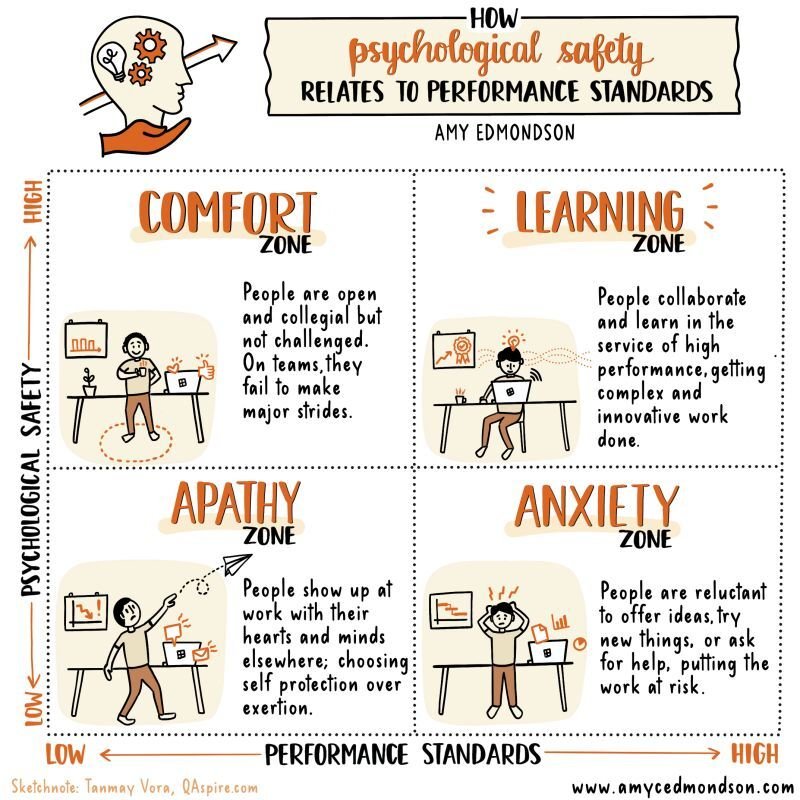6 Tips to Motivate Disengaged Teams!
“Help! How do I motivate this employee who seems so unmotivated?”
I heard this plea from a client during a coaching session, & thought about how common this challenge can be. It can seem near impossible to try to engage a team member who just doesn’t care, & many leaders start looking for ways to move that person towards the door. After all, a culture of engagement is extremely important to catalyze the results organizations want to accomplish, & keeping extra sources of friction is a surefire way to slow your progress.
It’s important to remember that in every workplace, there's a mix of engagement levels among the staff. While some employees are naturally proactive & engaged, others may appear disinterested or unmotivated. But don’t lose hope! It IS possible to inspire these unengaged employees in a way that upholds a productive & positive work environment.
Psychological Safety & Performance
Amy Edmondson is Harvard Business School's Novartis Professor of Leadership & Management, & she has done extensive research on organizational psychology. According to Edmondson’s work, she identified a correlation between psychological safety & performance standards in the work environment. Employees who display apathy towards their work are often situated in the lower left quadrant, where both psychological safety & performance standards are low. Folks in this quadrant exhibit a lack of engagement & may show up physically but not mentally, opting for self-protection over exertion.
So if you are witnessing people or teams stuck in this quadrant, focus on these 6 tips to build
their engagement:
1. Cultivate Psychological Safety:
Creating an environment where employees feel safe to express themselves without fear of negative consequences is essential. This means encouraging open communication, admitting mistakes, & learning from them. It's about leading by example and showing that it's okay not to know all the answers.
You need to fast-track the trust-building.
Trust is by Design- Here’s how we Scale Trust to Maximize Belonging & Results!
Click here for our Trust Slides2. Raise Performance Standards:
Set clear expectations & high standards, but ensure that these are achievable. Challenge your team with goals that require them to stretch their abilities, but also provide the support they need to succeed. This could be through training, mentoring, or just by being available to answer questions.
Take an honest look at how expectations are communicated to this person or team. How much is left to assumption? When tasks are assigned, are you including why they are important or how they will impact the team or drive the mission forward? And what does accountability look like? If this person has been able to coast with the results they are currently creating, then there’s no incentive to change their behavior any time soon.
3.Understand their Personal Motivators & Recognition Style:
Not everyone is motivated by the same things. Sure, having enough money to cover their living expenses is important, but according to Eduard Spranger, each individual is actually driven by a cluster of forces unique to them. The things that feel like recognition to someone who is heavily driven by a passion for knowledge will be very different from folks whose “why,” is to uphold specific values or beliefs or gain maximum return on investment. Find out what your team members really care about by using tools like the 12 Driving Forces assessment or asking about their preferred Language of Appreciation.
4. Customize Motivational Strategies:
Once you understand your employees’ motivators, develop personalized strategies that tap into those unique drivers. For instance, someone with a high Utilitarian drive may be motivated by bonuses or a clear pathway to promotion, while someone with a strong Social drive may find fulfillment in team collaborations or company service projects. Take a look at how you recognize & celebrate teams across the organization, as well as what might benefit this individual person or team.
5. Connect Work to "The Why:”
Help employees see how their work connects to their own big picture, the “why” behind their driving forces. Get curious & start the conversation about what they see as their purpose, mission, & values. In what way does this role or series of tasks support both their “why” & the the mission of the company?
6. Provide a Growth Path:
Offer opportunities for growth & learning. This can be particularly motivating for those that value the ability to expand their knowledge & contribute to the beauty & balance of their work. If they don’t know where their role will take them (or whether it brings them closer to their own personal goals), then they won’t be able to tap into excitement & engagement each day.
The key to motivating unengaged employees lies in creating a work environment that offers both psychological safety & challenging performance standards, as well as people-centric strategies. By getting curious & adapting your approach, you can boost engagement & enhance overall team performance (or at the very least, help the individual self-select to work with an organization where they are more engaged). Remember, the most effective motivational strategies are those that are as unique as the individuals you are looking to inspire.
You don’t have to do it alone. Learn how we can help create a program that leverages assessments & relationship-based leadership development to raise engagement for your team!
Pssst...I LOVE connecting with & growing my community! Feel free to connect with me on LinkedIn - see you there! 🤗



